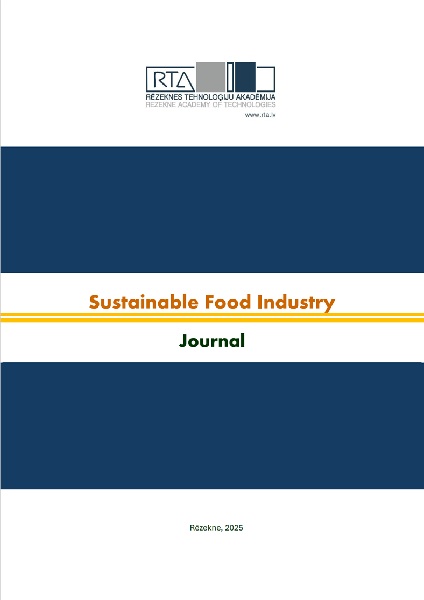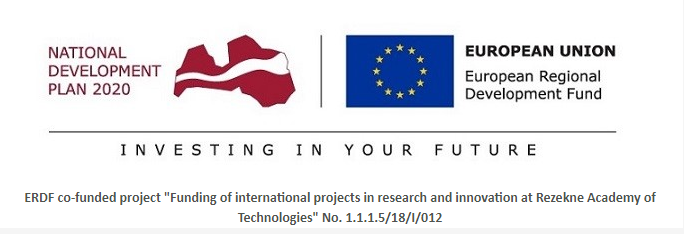RICE-LEGUME FLOUR AS AN ALTERNATIVE TO GLUTEN-CONTAINING FLOURIN BREAD BAKING
DOI:
https://doi.org/10.17770/sfi2025.1.1.8364Keywords:
alternative flour, alternative flour bread technology, bread, home productionAbstract
The article describes the development process of a new product - rice bean flour bread. The product is a functional alternative to classic wheat flour bread. The development of the new product is based on literature research and experiments. The ingredients of alternative flour bread are characterized. The most difficult thing in the development of alternative flour bread is the imitation of gluten, in connection with which gluten alternatives are studied. For its imitation, such groups of raw materials as hydrocolloids and proteins are offered. Conclusions are drawn about the importance of ingredients in alternative bread and the possibilities of gluten imitation. Bread made with just rice flour was crumbly, dry, and had a bad texture. Although adding potato starch decreased crumbling and increased cohesiveness, it also added an unwanted aftertaste. Tapioca starch lessened the aftertaste of potato starch and enhanced texture. Using eggs as a source of protein enhanced crumb structure and bread growth.
References
Arendt E.K. , Morrissey A., Moore M. M., Bello Dal F. (2008a). 13 - Gluten-free breads. Food Science and Technology, p 289-319, VII. Available: https://www.sciencedirect.com/science/article/abs/pii/B9780123737397500150 (viewed 10.11.2024.)
Arendt, E. K., Bello Dal F. (2008b). 19 - Functional cereal products for those with gluten intolerance. Woodhead Publishing Series in Food Science, Technology and Nutrition, p. 446-475. Available: https://www.sciencedirect.com/science/article/abs/pii/B9781845691776500199 (viewed 04.11.2024.)
Capelli, A. Olivia N., Bonaccorsi G., Lorini C., Cini E. (2020). Assessment of the rheological properties and bread characteristics obtained by innovative protein sources (Cicer arietinum, Acheta domesticus, Tenebrio molitor): Novel food or potential improvers for wheat flour? LWT, Volume 118, 108867 Available:https://www.sciencedirect.com/science/article/pii/S0023643819312095?casa_token=QVMq3xmELI4AAAAA:azxqk30iq0t_hWrGyrvHwUC9ksWrbISXUrph1eRN0jVXNCwCdN4hIzVzEj5nbOJc4l2-zmtRyg (viewed: 11.12.2024.)
Capelli, A., Olivia N., Cini E. (2020). A Systematic Review of Gluten-Free Dough and Bread: Dough Rheology, Bread Characteristics, and Improvement Strategies. Appl. Sci. 10 (18), 6559. Available: https://www.mdpi.com/2076-3417/10/18/6559 ( viewed 12.11.2024.)
Dulman, I. (n.y.). Vegetarianism. Available: https://www.kotuedisi.lv/vegetarisms/ ( viewed: 06.01.2025.)
Evlash V., Tovma L., Tsykhanovska I., Gaprindashvili N. (2019). Innovative Technology of the Scoured Core of the Sunflower Seeds After Oil Expression for the Bread Quality Increasing. Modern Development Paths of Agricultural Production, p. 665–679, Available: https://link.springer.com/chapter/10.1007/978-3-030-14918-5_65 (viewed 31.10.2024.)
Gavrilenko. E. (2001). Cooking technology, Riga: Turiba Business School, p.128.
Grivins M. (2023). Centre for Baltic and East European Studies, CBEES, Södertörn University, Ecological Concerns in Transition A Comparative Study on Responses to Waste and Environmental Destruction in the Region, Available: https://www.researchgate.net/profile/Sara-Persson-2/publication/370230710_Narrating_an_oilfield_in_transition/links/64479d58d749e4340e37f857/Narrating-an-oilfield-in-transition.pdf#page=162 (viewed 15.12.2024.)
Horstmann S. W., Foschiaa M., Arendt E. K. (2017). Correlation analysis of protein quality characteristics with gluten-free bread properties. Food & Function; Issue 7. Available: https://pubs.rsc.org/en/content/articlelanding/2017/fo/c7fo00415j/unauth (viewed 07.11.2024.)
Hoxha I., Xhabiri G., Deliu R. (2020). The Impact of Flour from White Bean (Phaseolus vulgaris) on Rheological, Qualitative and Nutritional Properties of the Bread. Open Access Library Journal, Vol.7 No.2. Available: https://www.scirp.org/journal/paperinformation?paperid=98121 ( viewed 09.11.2024.)
Kumar, S. (2016). Meat Analogues: Plant based alternatives to meat products- A review. International Journal of Food and Fermentation Technology. 5(2):107-119. Available: https://www.researchgate.net/profile/SatishKumar178/publication/305317336_Meat_Analogues_Plant_based_alternatives_to_meat_products-_A_review/links/5787c35008aecf56ebcb51ff/Meat-Analogues-Plant-based-alternatives-to-meat-products-A-review.pdf (viewed 06.01.2025.)
Larrosa V., Lorenzo G., Zaritzky N., Califano A. (2013). Optimization of rheological properties of gluten-free pasta dough using mixture design. lJournal of Cereal Science Volume 57, Issue 3, p. 520-526. Available: https://www.sciencedirect.com/science/article/abs/pii/S0733521013000428 (viewed 06.11.2024.)
Latvian Rural Advisory and Education Centre. A guide to home production. Ozolnieki: SIA "Latvian Rural Consulting and Education Centre". Available: https://www.pvd.gov.lv/lv/media/507/download?attachment (viewed 28/10/2024.)
Lerochem.eu. GASANTHAN RESIN, (E415 food quality). Available: https://lerochem.eu/lv/sakums/92-460-ksantana-sveki-e415-partikas-kvalitates-kg.html?srsltid=AfmBOorP6OxIJXOSKfnhODhXvcpkYmph_RwO287YeQ6B5mO10opT48Q5&utm_ (viewed 06.11.2024.)
López B. C. A., Junqueira R. G., Pereira A. J. G (2004). Flour mixture of rice flour, corn and cassava starch in the production of gluten-free white bread. Food Science and Technology. Braz. arch. biol. technol. 47 (1). Available: https://www.scielo.br/j/babt/a/v5XjmMVwSVvrj8NYXzSPtpz/?lang=en&format=html (viewed 12.11.2024.)
Maggio, A., Orecchio, S. (2018). Fatty Acid Composition of Gluten-Free Food (Bakery Products) for Celiac People. Foods 2018, 7(6), 95. Available: https://www.mdpi.com/2304-8158/7/6/95 (viewed 31.10.2024.)
Mateos R., Sarria B., Bravo L. (2019). Nutritional and other health properties of olive pomace oil. Critical Reviews in Food Science and Nutrition Volume 60, Issue 20.) Available: https://www.tandfonline.com/doi/abs/10.1080/10408398.2019.1698005 (viewed 31.10.2024.)
Mikolasova L., Ivanisova E., Tokar M., Snirc M., Lidikova J., Balazova Z. (2022). The Effect Of The Addition Of Various Types Of Oils On The Technological Quality Of Wheat Dough And Bread. Journal of microbiology, biotechnology and food sciences. Vol. 12 No. 2. Available: https://office2.jmbfs.org/index.php/JMBFS/article/view/5703 (viewed 31.10.2024.)
Mishra, S., Rai, T. (2006). Morphology and functional properties of corn, potato and tapioca starches. Food Hydrocolloids Volume 20, Issue 5, p. 557-566. Available: https://www.sciencedirect.com/science/article/pii/S0268005X0500010X?casa_token=Qa3ykDewqckAAAAA:9PvsLdEea2xtjD1Yxy0INwz7D8of2lT65ntC0pkZRkaW-rXNlBn5I3D9bbZ7JCWo-qTDqcmFXc (viewed 05.11.2024.)
Onyango C., Mutungi C., Unbehend G., Lindhauer M. G. (2011). Modification of gluten-free sorghum batter and bread using maize, potato, cassava or rice starch. LWT - Food Science and Technology. Volume 44, Issue 3, pages 681-68.6. Available: https://www.sciencedirect.com/science/article/pii/S0023643810003087 (viewed: 05.11.2024.)
Ren, Y. (2020). A comprehensive investigation of gluten free bread dough rheology, proving and baking performance and bread qualities by response surface design and principal component analysis. Food Funct. 11, p. 5333-5345. Available: https://pubs.rsc.org/en/content/articlehtml/2020/fo/d0fo00115e (viewed 11.11.2024
Ronie, M.E., Mamat, H. (2022). Factors affecting the properties of rice flour: a review. Food Research 6(6), p. 1-12. Available: https://www.researchgate.net/profile/Macdalyna-R/publication/365135511_Factors_affecting_the_properties_of_rice_flour_a_review/links/636bc98d431b1f53008410dd/Factors-affecting-the-properties-of-rice-flour-a-review.pdf (viewed 12.11.2024).
Shewry, P. (2019). What Is Gluten—Why Is It Special? Sec. Nutrition and Food Science Technology Volume 6. Available: https://www.frontiersin.org/journals/nutrition/articles/10.3389/fnut.2019.00101/full (viewed: 12.11.2024.)
Sperohope.com (2025). Hydrocolloids: properties, types, application and examples. Available: https://lv.sperohope.com/hidrocoloides-propiedades#menu-14 ( viewed: 13.11.2024.)
Šmídová, Z., Rysová, J. (2022). Gluten-Free Bread and Bakery Products Technology. Foods, 11(3), 480. Available: https://www.mdpi.com/2304-8158/11/3/480 ( viewed 11.11.2024.)
Tres A., Tarnovska N., Varona E., Quintanilla-Casas B., Vichi S., Gibert A., Vilchez E., Guardiola F. (2020). Determination and Comparison of the Lipid Profile and Sodium Content of Gluten-Free and Gluten-Containing Breads from the Spanish Market. Plant Foods for Human Nutrition. Vol. 75, p. 344–354. Available: https://link.springer.com/article/10.1007/s11130-020-00828-w (viewed 30.10.2024)
Wesleya S. D., Andréa M. H. B., Clerici S. P. T. M. (2021). Gluten-free rice & bean biscuit: characterization of a new food product. Heliyon, Vol. 7, Issue 7. Available: https://www.cell.com/heliyon/fulltext/S2405-8440(21)00061-X (viewed 09.11.2024.)
Wilman, L. (2015). The study of gluten-free flour and its products. Doctoral thesis. p. 21. Available: https://llufb.llu.lv/dissertation-summary/food-science/Laila_Vilmane_prom_darba_kopsavilk2015_LLU_PTF.pdf?utm_ ( viewed: 09.11.2024.)
Ziobro R., Juszczak L., Witczak M., Korus J. (2015). Non-gluten proteins as structure forming agents in gluten free bread. Journal of Food Science and Technolgy; 53(1):571–580. Available: https://pmc.ncbi.nlm.nih.gov/articles/PMC4711467/?utm_source= (viewed 07.11.2024.)
Downloads
Published
Issue
Section
License
Copyright (c) 2025 Vizma Emily Vasilyeva, Rasma Tretjakova

This work is licensed under a Creative Commons Attribution 4.0 International License.



